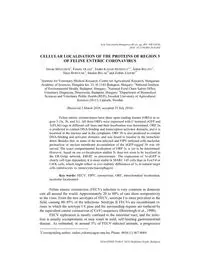
2018 Cellular localisation of the proteins of region 3 of feline enteric coronavirus PDF
Preview 2018 Cellular localisation of the proteins of region 3 of feline enteric coronavirus
Acta Veterinaria Hungarica 66 (3), pp. 493–508 (2018) DOI: 10.1556/004.2018.044 0236-6290/$ 20.00 © 2018 Akadémiai Kiadó, Budapest CELLULAR LOCALISATION OF THE PROTEINS OF REGION 3 OF FELINE ENTERIC CORONAVIRUS István MÉSZÁROS1, Ferenc OLASZ1, Enikő KÁDÁR-HÜRKECZ1,2, Ádám BÁLINT3, Ákos HORNYÁK3, Sándor BELÁK4 and Zoltán ZÁDORI1* 1Institute for Veterinary Medical Research, Centre for Agricultural Research, Hungarian Academy of Sciences, Hungária krt. 21, H-1143 Budapest, Hungary; 2National Institute of Environmental Health, Budapest, Hungary; 3National Food Chain Safety Office Veterinary Diagnostic Directorate, Budapest, Hungary; 4Department of Biomedical Sciences and Veterinary Public Health (BVF), Swedish University of Agricultural Sciences (SLU), Uppsala, Sweden (Received 2 March 2018; accepted 25 July 2018) Feline enteric coronaviruses have three open reading frames (ORFs) in re- gion 3 (3a, 3b, and 3c). All three ORFs were expressed with C-terminal eGFP and 3xFLAG tags in different cell lines and their localisation was determined. ORF 3a is predicted to contain DNA-binding and transcription activator domains, and it is localised in the nucleus and in the cytoplasm. ORF 3b is also predicted to contain DNA-binding and activator domains, and was found to localise in the mitochon- drion. Besides that, in some of the non-infected and FIPV-infected cells nucleolar, perinuclear or nuclear membrane accumulation of the eGFP-tagged 3b was ob- served. The exact compartmental localisation of ORF 3c is yet to be determined. However, based on our co-localisation studies 3c does not seem to be localised in the ER-Golgi network, ERGIC or peroxisomes. The expression of 3c-eGFP is clearly cell type dependent, it is more stable in MARC 145 cells than in Fcwf-4 or CrFK cells, which might reflect in vivo stability differences of 3c in natural target cells (enterocytes vs. monocytes/macrophages). Key words: FECV, FIPV, coronavirus, ORF, mitochondrial localisation, nucleolar localisation Feline enteric coronavirus (FECV) infection is very common in domestic cats all around the world. Approximately 20 to 60% of cats show seropositivity to the virus. From the two serotypes of FECV, serotype I is more prevalent in the field, causing 80–95% of the infections. Serotype II FECVs are recombinant vi- ruses in which the serotype I S gene and the surrounding regions are replaced by the equivalent canine coronavirus (CCoV) sequences (Herrewegh et al., 1998). FECV replication is mostly confined to the intestinal tract, and the infec- tion is usually asymptomatic or may result in mild, self-limiting gastrointestinal disease. As estimated, in around 5% of FECV-infected animals, a progressive *Corresponding author;
